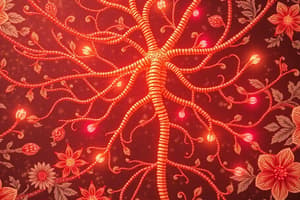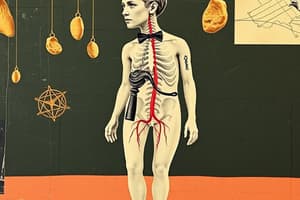Podcast
Questions and Answers
What neurotransmitter is primarily released by preganglionic neurones in both the sympathetic and parasympathetic divisions of the autonomic nervous system?
What neurotransmitter is primarily released by preganglionic neurones in both the sympathetic and parasympathetic divisions of the autonomic nervous system?
- Adrenaline
- Noradrenaline
- Acetylcholine (correct)
- Dopamine
What is a primary function regulated by the autonomic nervous system?
What is a primary function regulated by the autonomic nervous system?
- Smooth muscle contraction (correct)
- Sensory perception and reaction
- Voluntary muscle movement
- Cognitive memory processing
Which of the following receptors does ACh act upon in the postganglionic neurones?
Which of the following receptors does ACh act upon in the postganglionic neurones?
- Serotonin receptors
- Adrenergic receptors
- Nicotinic receptors (correct)
- Muscarinic receptors
What is the main neurotransmitter released by sympathetic postganglionic neurones?
What is the main neurotransmitter released by sympathetic postganglionic neurones?
Which of the following correctly describes the organization of the autonomic nervous system?
Which of the following correctly describes the organization of the autonomic nervous system?
Which division of the autonomic nervous system primarily prepares the body for 'fight or flight' responses?
Which division of the autonomic nervous system primarily prepares the body for 'fight or flight' responses?
Which neurotransmitter is released by the chromaffin cells of the adrenal medulla?
Which neurotransmitter is released by the chromaffin cells of the adrenal medulla?
In the parasympathetic nervous system, postganglionic neurones primarily release which of the following?
In the parasympathetic nervous system, postganglionic neurones primarily release which of the following?
Which of the following types of muscles does the autonomic nervous system primarily control?
Which of the following types of muscles does the autonomic nervous system primarily control?
Which component is NOT part of the autonomic nervous system?
Which component is NOT part of the autonomic nervous system?
Study Notes
Autonomic Nervous System (ANS)
- Regulates many physiological functions, largely outside voluntary control
- Primarily controls smooth muscle (vascular and visceral), exocrine gland secretion, and heart contraction (frequency and force).
- Composed of sympathetic and parasympathetic divisions.
- Each division has two neurons in series: preganglionic and postganglionic neurons.
- The exception to this is the adrenal gland.
Neurotransmitters
- Preganglionic neurons of both divisions release acetylcholine (ACh).
- ACh acts on nicotinic receptors on the postganglionic neuron (ion channel).
- Sympathetic postganglionic neurons are typically adrenergic, releasing noradrenaline (NA), except for sweat glands and piloerector muscles.
- Parasympathetic postganglionic neurons are typically cholinergic, releasing ACh, which acts on muscarinic receptors on target cells (what is the receptor type at the NMJ?).
- Adrenal chromaffin cells are considered specialized postganglionic sympathetic neurons, releasing adrenaline into the bloodstream.
Receptors
- Sympathetic nervous system's noradrenaline (NA) and adrenaline act on adrenoreceptors, which are G protein-coupled receptors (not integral ion channels).
- Adrenoreceptors have subtypes: α-adrenoreceptors (1 & 2) and β-adrenoreceptors (1 & 2).
- Parasympathetic postganglionic neurons release ACh, which acts on muscarinic receptors on the target cells (G protein-coupled receptors - M1, M2, and M3).
General Functions
- The sympathetic and parasympathetic nervous systems continuously stimulate tissues, requiring only low-frequency stimulation for full activation.
- The sympathetic drive to different tissues is regulated independently.
- For example, sympathetic activity to the heart can increase without affecting the gastrointestinal tract.
- In “fight or flight” situations, there is a coordinated sympathetic response (generalized response).
Examples of ANS control
| Organ | Sympathetic Effect | Receptor | Parasympathetic Effect | Receptor |
|---|---|---|---|---|
| Pupil of Eye | Dilatation (contracts radial muscle) | α1 | Contraction (contracts sphincter muscle) | M3 |
| Airways of Lungs | Relax | β2 | Contract | M3 |
| Heart | Increase rate and force of contraction | β1 | Decrease rate | M2 |
| Sweat glands | Localized secretion (ex.palms) | α1 | No effect | - |
| Sweat glands | Generalized secretion | M3 | - | - |
- Search for the effect of the ANS on the rest of body organs and tissues.
Studying That Suits You
Use AI to generate personalized quizzes and flashcards to suit your learning preferences.
Related Documents
Description
Explore the intricacies of the Autonomic Nervous System (ANS) with this quiz. Learn about its regulation of physiological functions, the roles of sympathetic and parasympathetic divisions, and the neurotransmitters involved. Test your understanding of the components and mechanisms that govern involuntary body processes.




